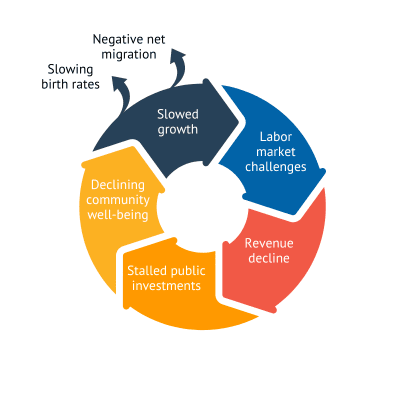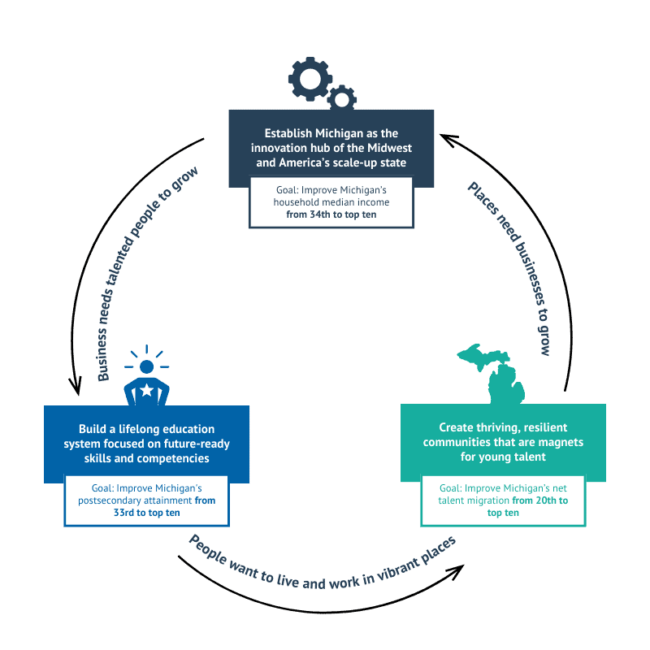The Growing Michigan Together Council marks the tenth governor’s council that we have staffed throughout PSC’s history. We are committed to this work because we value making sure that all voices are lifted, recommendations are based on facts and research and policymakers have a solid blueprint for moving Michigan forward.
Governor’s growth council looks at how to rebuild a prosperous future for Michigan
Whether it’s our kids leaving to find their first jobs, friends moving to a bigger city or coworkers and companies relocating to a new headquarters, many of us know firsthand the negative changes in Michigan’s population and economy — the overall extent of the decline, however, can be surprising.
In June 2023, Gov. Gretchen Whitmer charged the Growing Michigan Together Council with understanding the magnitude of our population decline and its impact on Michiganders’ way of life, along with offering recommendations for reversing this trend to build a brighter future for all.
For six months, the 27-member council wrestled with how to rise above partisanship and put forward recommendations that will result in positive changes for generations of Michigan residents.
From reviewing outside experts’ presentations to commissioning studies, the council dug into expert data on economics, population, infrastructure and education to develop an in-depth analysis of the population challenges facing Michigan.
The conclusions in the 86-page GMTC report are unmistakable. The growth cycle in our state is broken — and has been for nearly 40 years.
“After six months of investigation, study and debate, it’s clear that population decline and its contributing factors are a significant threat to our state’s future prosperity and well-being. We find ourselves in an unfolding crisis and must act now.”
— Shirley Stancato and Amb. John Rakolta
Chairs, Growing Michigan Together Council
Healthy growth cycle

Cycle of depressed growth

A critical crossroads
Once the “go-to” place to raise a family and have a career, get a solid education, drive your Michigan-made car on strong infrastructure and easily find a house to meet your family’s needs, the report shows our state sits far behind others.
Since 1980, Michigan has grown just 8.8% compared to 46.3% U.S. growth. If current trends aren’t addressed, we will begin losing population by 2040. This has also affected our shared and individual prosperity. While Michigan’s median income was once over 117% of the national average in the 1970s, today, we are below the national average, at 91%. We are 49th in population growth, 34th in median income and significantly lagging in educational outcomes and attainment.
We are failing to prepare our people for the jobs of the future, struggling to attract and retain talented young people and, overall, not remaining competitive enough to ensure Michiganders want to continue calling Michigan their home.
These failures mean our communities suffer from a lost tax base and are unable to support the public amenities, schools and infrastructure that will attract business to our state. We are caught in a cycle of depressed growth, and until we address these outcomes, Michigan risks no longer being competitive in the fight for our future.
Built on the idea that “by 2050, Michigan will be a top-10 state for population growth,” the council’s complete vision weaves together the ideas we need to create a solid foundation for a growing state, thriving communities and a vibrant economy.
Growth takes time — and commitment
The sizeable amount of data presented to the council and its workgroups has proven that it was not just one person, one policy or one single point in time that set Michigan on the path to population decline. Instead, it took decades of apathy, structural deficiencies and political discord to bring us to this moment.
Reversing these trends and nurturing long-lasting population growth requires a clear vision and sustained commitment. The GMTC process allowed stakeholders a space to come together to create a shared vision.
Armed with the in-depth analysis of the real challenges we face and a shared vision for our future, the council delivered to the governor a set of actionable recommendations designed to regain our competitiveness.
Council sets path for change
The GMTC report provides policymakers with three strategies with 10 bold recommendations to help grow Michigan’s population, which were approved 19-1 by the council and presented to the governor, the Michigan House of Representatives and the Michigan Senate in December 2023. Below is a snapshot of the final strategies and recommendations:
Establish Michigan as the Innovation Hub of the Midwest and America’s Scale-up State
To transform our economy: Michigan must develop an economic growth plan that embraces its entrepreneurial and innovation roots and focuses on efforts to attract and retain young talent.
Build a lifelong learning system focused on future-ready skills and competencies
To enable our students to thrive: Michigan must build a lifelong learning system that includes a guarantee that all students achieve a new standard of education that ensures they have future-ready skills and competencies to thrive in work and life before they leave high school; strengthens the governance, funding and accountability of our education system; and connects students to a postsecondary education system or other workforce training skills to succeed in the jobs of tomorrow.
Create thriving, resilient communities that are magnets for young talent
To attract talent: Michigan must develop regional public transit systems, develop and revitalize housing stock and future-proof our infrastructure, ensuring it is climate resilient and reliable.


The appointment of chief growth officer Hilary Doe, housed in the Michigan Economic Development Corporation, led to an extensive public engagement campaign in tandem with the council’s research. More than 11,000 Michiganders and 2,700 people from 15 metropolitan areas across the country made their voices heard during the campaign. Doe’s appointment means that compared to other governor’s councils, there is an added layer of accountability and support to ensure active engagement from other state agencies and key partners. This will also ensure that the council’s third milestone —continuing the conversation— comes to life.
Navigating the road ahead: Who will be driving the change?
As a company devoted to crafting public policy for the betterment of Michigan, Public Sector Consultants is excited about the future implementation of these recommendations. Who is ready to pick up the reigns and move these recommendations forward? What does implementation look like?
For institutions of higher education, implementation looks like doubling down on apprenticeships and work-based learning options for students as a proven means to retain young talent. Northern Michigan University, a workgroup participant, recently unveiled a new Rural Fellowship Program in partnership with InvestUP and MEDC to provide undergraduate students immersive, project-based internships.
Implementation of the recommendations will require many state departments to lead the development and funding aspects, with community partners working alongside them. To achieve the ambitious housing goals in the plan, the Michigan State Housing Development Authority announced $1.4 billion in new investments in housing construction and rehabilitation that will spur community development and bring more affordable and desirable housing stock to communities across Michigan.
For Michigan businesses and research institutions, implementation looks like championing the recommendations that spur innovation and contribute to business and talent attraction. The proposed $100 million research and development tax credit will make Michigan economic development incentives more competitive and spur new ideas and businesses. For the Detroit Regional Chamber, the conversation continues through its two annual policy conferences — the Detroit Policy Conference and the Mackinac Policy Conference — both featuring agendas that build on the three pillars of the GMTC report.
For our pre-K-12 educational institutions, implementation of the recommendations means a wholesale shift in how we approach educating our students, redefining teachers’ and administrators’ accountability and allowing students to move on to two free years of postsecondary education as soon as they master the new competency-based education standards in high school. Although this concept sounds similar to Governor Whitmer’s budget proposal, the council’s vision is more than just providing access to community colleges. The council’s Michigan Education Guarantee is intended to create a new standard that ensures high school students are college-ready from the get-go and that we guarantee students meet this new standard before they can access additional postsecondary opportunities. This is a great example of how the council’s work can encourage all Michiganders to ask, “How can we go further? What more can we do to build a solid foundation that ensures our students, families, communities and businesses thrive?”
As we have been for the past 45 years, PSC looks forward to partnering with champions across Michigan as we roll up our sleeves and make long-lasting policy changes for the next generation of Michiganders to prosper.

About the council workgroups
The council’s recommendations were built on the work of 60 individuals who participated across four workgroups focused on Pre-K-12 Education; Higher Education; Infrastructure and Places; and Jobs, Talent and People. PSC was proud to not only provide staff to the council but also to collaborate with the Boston Consulting Group and the National Center on Education and Economy to support the workgroups.


